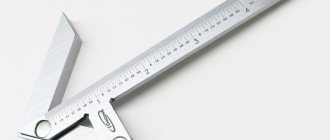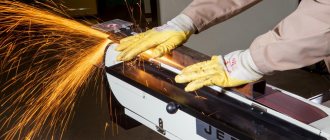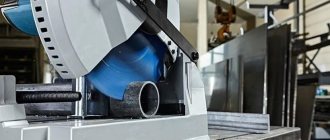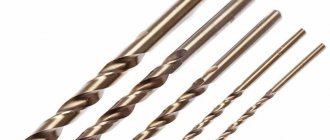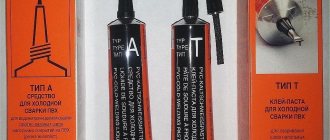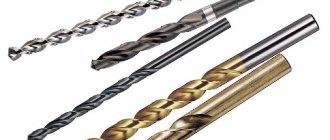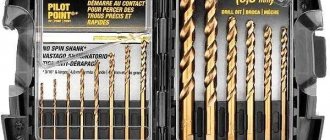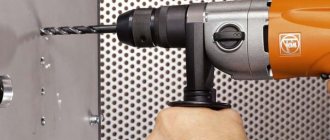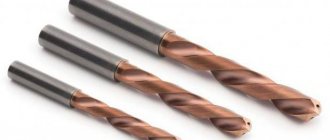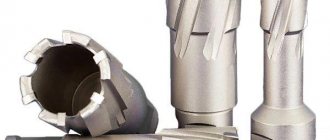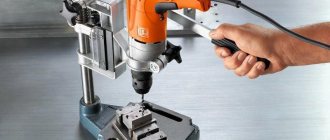SHARE ON SOCIAL NETWORKS
FacebookTwitterOkGoogle+PinterestVk
The modern market is distinguished by a variety of tools used for all types of work. Cone drills for metal are professional products that are characterized by a long service life, versatility and ease of use. To select the necessary tool, it is recommended to study the basic properties of such devices.
Cone drills for metal are characterized by versatility, long service life and ease of use
Characteristics and features of conical drills for metal
All conical devices, depending on the shape of the working element, are divided into two groups: smooth and stepped. Both product options have a conical shape and are used for processing metal sheets of small thickness. The smooth variety is less convenient, since it does not have the ability to produce an exact diameter. When working with such a drill, it is necessary to periodically stop and take appropriate measurements.
All cone drills for metal are divided into two groups: smooth and stepped
Helpful information! Stepped cone drills, due to a clear gradation of levels, each of which has its own diameter, are more convenient and are recommended for people who do not have experience working with such tools. Each step in such a product has a digital marking, which allows you to quickly determine the desired diameter.
Both types of tools are equipped with a special groove with sharp edges. It is thanks to the cutting edges that the metal material is drilled. Grooves can have different shapes. All conical devices are characterized by good strength. Most of them can be sharpened, which is a serious advantage that allows you to extend the service life of the drill.
It is important to understand that such devices replace several tools that are used under normal conditions to make holes in metal sheets. To work with such products, screwdrivers or drills are used. Taper tools are suitable for drilling holes at high speed. At the same time, their use guarantees high quality of the edges of the holes. In this case, the possibility of burrs, which under normal conditions must be removed, is eliminated.
Taking into account the above characteristics, we can say that these tools are ideally designed for working with metal sheets. In addition, their use allows the processing of other materials, which makes them truly universal and indispensable. The main task of such drills is to make holes, but they can be used for other purposes. Quite often, conical products are used to eliminate defects caused by drilling with other drilling elements.
For people without experience, stepped cone drills are easier to use
Cone drills for metal: advantages and disadvantages
All cutting type tools have positive and negative features. Before purchasing a conical product, it is recommended that you familiarize yourself with its advantages in more detail. One of the main advantages of such devices is that they can be used to make holes of different sizes. One drill of this type replaces a full set of cutting tools.
Such products are characterized by high strength characteristics. This reduces their wear rate. Another advantage, which also affects the duration of operation, is the speed of operation of such tools. Using a conical device, you can make a hole much faster than using other cutting elements. This eliminates the possibility of the drill overheating.
Stepped herringbone-shaped devices, also called carrot drills, have a sharp tip. This shape makes it much easier to insert into metal material of any density. Such products are also used as grinding elements.
Conical devices provide a smooth expansion of the diameter of the hole in a metal material (and not only). Thus, the likelihood of sheet deformation is reduced. They can not only be used on manual equipment, but also installed in stationary machines, which is also a serious advantage.
The sharp tip of the cone drill for metal makes it easier to insert into material of any density
The surface of conical parts can be equipped with a special protective coating. The modern market offers the buyer models with titanium and diamond coating. The durability of these products, which increases their service life, allows for less frequent sharpening. You can sharpen a tapered step drill, like any other, using a grinder. Such tools are a good alternative to core drills. The large dimensions of conical devices make it possible to make large holes.
Note! Such drills can be used to make holes not only in sheets of metal, but also in pipes (round and profiled), as well as corners.
The versatility of such tools cannot be criticized. However, it is worth remembering that they cannot be used for metal products whose wall thickness exceeds 7 mm. The optimal application option is drilling holes in thin-sheet parts (no more than 4 mm). Metal drills of this type have the majority of positive reviews from users.
If you have special adapters, such drills can even be installed in an angle grinder. The only significant drawback of such devices is their rather high cost.
The surface of the conical parts of the drill can be coated with titanium or diamond sputtering
Advantages and disadvantages of the tool
The metal crown cutter in question is characterized by the presence of quite a large number of advantages. They look like this:
- The design of the product is designed in such a way that cutting is carried out along the contour. This point also determines the need to use powerful equipment.
- Core drills and annular cutters for metal are used to obtain a surface with the required roughness index. This cannot always be achieved using a conventional drill.
- You can install metal milling equipment on a wide variety of equipment. Examples include drills and milling machines.
- A similar design option is used for multi-tool processing.
- It can remove quite a large amount of material in one pass. This moment significantly increases the cutting speed.
- To obtain metal shavings requires less energy.
- Increased productivity is ensured by the use of high-speed steel in the manufacture of the cutting edge. It is resistant to heat.
- The required accuracy and cutting speed are ensured.
- During operation, a minimal amount of noise is generated. This can also be called a significant advantage of such a tool.
High productivity is also ensured by the arrangement of a large number of teeth on the working surface.
The crown-type equipment of milling machines has only one drawback - high cost. Difficulties arising during manufacturing increase cost and reduce maintainability. In this case, surface sharpening can only be done using special equipment.
Scope of application of conical type metal drills
Conical cutting tools are designed to last for a long time without interruption. This is achieved through strong edges, which are the edges of the grooves. Such drills are completely independent. Therefore, in this case there is no need to use special centering devices to organize the hole.
The scope of application of such tools is quite wide. The shape of the cutting edges located at the edges of the grooves allows you to significantly expand the functionality of the tools. Such drills can be used for processing not only thin-sheet steel, but also other materials, such as:
- cast iron;
- aluminum;
- copper;
- brass;
- plastic;
- drywall;
- tree.
They are also actively used when working with stainless steel. Metal drills of this type are distinguished by several options for the arrangement of working grooves. The channels can have a straight or spiral shape. The second option is characterized by greater efficiency, but sharpening a tool with such a channel is much more difficult.
Cone drills for metal can be used not only for working with thin-sheet steel, but also for a number of other materials
The pointed tip of the conical parts facilitates easy entry into the metal material and also has another advantage. Its shape allows it to cope with vibration effects that appear during metal drilling. Conventional models of cutting products do not have this advantage. An example is a 13 mm metal twist drill.
These products are actively used when installing plumbing equipment, and they are also often used when repairing automotive equipment. What other uses for conical parts are there? Among other things, they are in demand in construction and in the manufacture of electrical panels.
What are they used for?
Core drills are widely used to make through holes in sheet metal, wood, plastics, drywall, plywood, and chipboard. The simple technology for drilling large diameters, with the minimum possible application of force, has made these drills an indispensable tool not only for the above materials, but also for other types of work. Special purpose drills are used for:
- obtaining holes of the correct shape in concrete and stone building structures;
- drilling ceramic tiles, natural stone, sheet glass and other fragile materials;
- horizontal drilling when laying utilities;
- production of flat circles and cylindrical workpieces without turning.
To do this, in some cases, the design of the drill (drill) provides for lengthening its working part by adding appropriate inserts.
To work with concrete, only diamond-coated or tipped core drills are used. There are 2 groups here:
C1 – the crown can withstand loads during operation up to 5 MPa.
C2 – the crown can withstand loads during operation up to 2.5 MPa.
Based on the equipment you have, you should choose the crown group itself.
Features of the shape and dimensions of conical drills
To correctly select a conical cutting device, it is necessary to clearly understand what shape options for these products are available on sale. Each type of product has its own advantages and disadvantages. Let's look at three main types of such tools:
- ordinary (stepped herringbone);
- truncated, without a guide point;
- combinations of two conical parts.
The maximum diameter of cone drills for metal is 60 mm
The latter option consists of two segments, each of which has a different angle of inclination of the surface. The grooves that these products include can also have different shapes.
Helpful information! The maximum diameter of such drills may vary, but most often there are models in which this figure is 32 mm. A 4-32 mm cone drill for metal can be purchased at a specialized store or ordered online.
Today on sale you can find larger models of drills, for example, stepped products with a maximum diameter of 40 or 50 mm. It is worth saying that this figure for the largest models does not exceed 60 mm.
When choosing a conical cutting device, it is also recommended to pay attention to the shape of its tail. This drill element is used to secure the tool in the drill chuck. The following shank shape options are available:
The tail part of a cone drill for metal can be cylindrical, triangular and hexagonal
- cylindrical;
- triangular;
- hexagonal
The last two varieties are recommended by many craftsmen, as they allow the drill to be more tightly fixed in the working tool. When using triangular and hexagonal specimens, rotation is eliminated, therefore reducing the risk of injury when drilling a metal surface.
Smooth products expand closer to the tail section, which is fixed in the chuck. They, unlike stepped ones, do not have a clear gradation of diameters. In the stepped version of the conical cutting tool, the height of the levels is 5 mm. However, in some cases this indicator may be different (for example, 4 or 6 mm). Metal drills have a pitch that is 1 mm up to a step with a diameter of 12 mm. Larger levels are characterized by a step of 2 mm.
It is important to remember that you can determine the maximum permissible thickness of the metal material at which it is permissible to use a particular drill yourself. This parameter, as a rule, completely repeats the height of the levels of the conical device.
The height of the levels in step drills for metal is 2-6 mm
Types of instruments
In addition to the classic two-cutting version of a circular drill, there are one- and three-cutting models. In the design of a single-cut drill, the cutting part is directly fixed to the rod. The cutter and centering lance are equipped with carbide plates. They make it easier for a ballerina to work on tiles.
In three-incisor models, the incisors are mounted on a round platform on which there are grooves. The cutters move along these grooves. They have a scale. Correctly set size allows you to cut more accurately and quickly.
Currently, some models are equipped with a protective grille made of plastic. It improves work efficiency and convenience.
The ballerina for metal is equipped with plates made of hard alloy with sharpening of a cutting turning tool. High cutting force dictates the use of stationary or portable radial drilling machines. Basically, holes are cut in galvanized sheets, the thickness of which does not exceed one millimeter.
Recommendations from experts on choosing a cone drill
Many people who are not well acquainted with the features of various cutting attachments find it difficult to decide on the purchase of such a tool. In order to avoid making mistakes when choosing, you need to understand a few basic points.
First of all, you need to remember that all nozzles differ in color. This is a very important point, since its technical characteristics depend on the color of the product. For example, the steel color of the working part indicates that it has not been subjected to additional temperature (or any other) treatment.
Steel-painted fixtures are not characterized by high strength and, accordingly, are more susceptible to wear. They are recommended to be used exclusively for making holes in thin-sheet material, as well as for processing plastic, drywall and wood. Cone drills for metal of this type have the lowest cost.
The black color of the cutting tool indicates that the product has undergone additional high-temperature processing. Such devices have higher strength, which helps to increase their service life.
Smooth cone drills widen closer to the tail and do not have a clear gradation of diameters
Note! The tool must be selected based on its operational purpose. The dimensions of the product may vary, so it is worth deciding in advance which holes will be made with it. Most often on sale you can find conical drills for metal 6-36 and 4-32 mm.
Another option common in the modern market is golden cones. These models have a protective coating of titanium nitride. Due to this, their technical characteristics significantly exceed previous analogues.
Related article:
Step drills for metal: the best solution for beginners and professionals Step drills for metal. What are they used for? Advantages of step drills. Varieties. Tips for choosing.
In stepped options, the height of the levels, as mentioned above, averages 5 mm. Metal drills should not have a deviation in this indicator of more than 1 mm. This is worth remembering when purchasing a tool.
What else should you pay attention to? The brand of the instrument plays an equally important role. Craftsmen do not recommend buying products made by little-known Chinese companies, since in this case the chance of purchasing low-quality or defective products increases significantly. Domestic drills have a shorter working life when compared with their foreign counterparts.
On sale you can most often find conical drills for metal 4-22 and 6-36 mm
Marking of cone cutting tools: what you need to know
The technical characteristics of such cutting products are indicated in the form of markings that are applied to the outer surface of the tail section. Knowledge of the basic designations allows you to select a high-quality product that is most suitable for specific operating conditions. Let's take a closer look at what information is encrypted in the marking:
- material of manufacture;
- diameter;
- accuracy class.
Deciphering the marking is a very important stage, so it is worth familiarizing yourself in more detail with its possible options. Most products of this type have a pitch of 1 mm. Metal drills, which have a herringbone shape, differ in different dimensions. This information must be included in the labeling.
Most often, the letter designation is the beginning of the marking. Most drills that can be purchased today are marked with the letter "P". This designation indicates that high-speed alloy steel was used to manufacture the device. This material has high strength characteristics.
Technical characteristics of conical drills for metal are indicated in the form of markings on the surface of the tail section
Next comes the next letter, followed by a certain number. This designation contains information about the metal that was used as an additive to the alloy steel. The number indicates what percentage of alloy is in the product.
Note! Marking is not applied to products whose diameter is less than 2 mm. Metal drills of this type have a shank that is too small.
After the percentage of minor metal, the marking indicates the maximum and minimum diameters, as well as the accuracy class of the device. It is worth noting that the letter designation HSS is often found on such products. Metal drills of this type are made of high-speed steel. After the initial mark, the marking contains information about the additional material used in the production of the product.
How to properly drill holes with a cone drill: instructions
The operation of a conical cutting element has some peculiarities when comparing this process with the use of conventional spiral devices. Thus, in order for a beginner who has no experience with such a tool to understand the features of use, he must study the instructions. It is not recommended to deviate from the work algorithm during work, as this can lead to various problems.
When choosing a tool into which a cone drill will be installed, it is worth considering that it must reach a speed of 3 to 5 thousand rpm
To study the technical characteristics of the cutting part, you can additionally familiarize yourself with its drawing. Drills and their diagrams can be easily found on the World Wide Web. The first stage is preparatory. First, you will need to purchase and prepare all the necessary tools and materials. Let's look at what exactly is needed in this case:
- conical cutting tool;
- drill;
- workpiece in which the hole will be made.
The choice of a conical tool depends entirely on the diameter of the hole to be made in the workpiece. When choosing a drill into which the drill will be installed, it is worth considering that the tool must be able to develop the required speed (from 3 to 5 thousand rpm). Before starting work, experts advise fixing an additional handle on the drill. Sheets made of steel, soft metals, as well as a variety of synthetic materials can be used as a workpiece.
Conventional drills with conical shanks are much more difficult to use for making holes in metal. Such products have a simple design, which does not contribute to accurate work performance. After preparing all the necessary tools, you can proceed directly to drilling the workpiece. The procedure in this case consists of 4 stages.
Having fixed the drill, you need to choose the correct direction of movement of the tool chuck
First of all, you need to fix the cutting device in the chuck of the electronic tool. Next, you will need to select and apply the appropriate markings in the place that was chosen for drilling the hole.
At the next stage, the cutting device is applied to the surface of the workpiece and drilling is performed. It is important to remember that the product must be located in a strictly perpendicular position in relation to the workpiece. During the drilling process, this angle must be strictly observed. Metal drills, which have a conical shape, are used to make different diameters and are independent tools.
The final stage is gradual introduction into the metal material with increasing speed. The end result of this work is a neat hole, the edges of which are free of burrs and any other defects.
Note! Many craftsmen note that the ease of use of such a drill is its main advantage. Therefore, such cutting products are great for beginners who do not have relevant experience.
The cone drill for metal must be strictly perpendicular to the workpiece
How to work with a ring drill for metal?
To drill with a metal crown, you first need to make markings and determine where the center of the future hole will be located. The centering drill is installed at the intended center and drilling is carried out. Next, a special spring retracts the centering drill into the shank, and drilling of the surface with a crown begins. At the end of the work, the spring pushes the resulting metal cylinder out of the crown. The resulting hole has a perfectly round shape and smooth edges without burrs; it does not require additional grinding.
